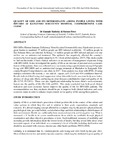| dc.description.abstract | HIV/AIDs (Human Immune Deficiency Virus/Acquired Immunodeficiency Syndrome) possess a
great burden to mankind. 37 million people are HIV infected worldwide. 19 million people in
Sub-Saharan Africa are infected. In Kenya, 1.6 million people are HIV infected and just over one
million are on antiretroviral treatment. The epidemic has negatively affected the country’s
economy by lowering per capital output by 4.1%. (Avert global statistics, 2017). This study sought
to find out the trends of basic clinical indicators as an outcome of management of patients living
with HIV/AIDS. It also investigated the quality of life as an outcome of personal socio-economic
factors of the patients. Data was collected cross-sectionaly using a questionnaire among 215 people
living with HIV/AIDS and on antiretroviral therapy treatment at Machakos in Kangundo Subcounty
Hospital Comprehensive care clinic in 2017. Data analysis was done with SPSS, 20 using
multiple correlation (R) statistic, t - test and chi –square, at P ≤ 0.05 and 95% confidence Interval.
Results indicated that having viral suppression below detectable levels, moderate body mass index,
absence of drugs side effects and having no other diseases contributed to improved quality of life
(R= 0.715, P<0.001). There was also significant relationship between client’s socio-economic
factors and the quality of life (R= 0.82, p=000). This study concluded that, both good clinical
indicators and socio economic factors improve the quality of life for HIV/AIDs patients. The
recommendation was that, emphasis should be put to improve both clinical indicators and socio
economic status in order to enhance improvement on the quality of life among these patients. | en_US |

